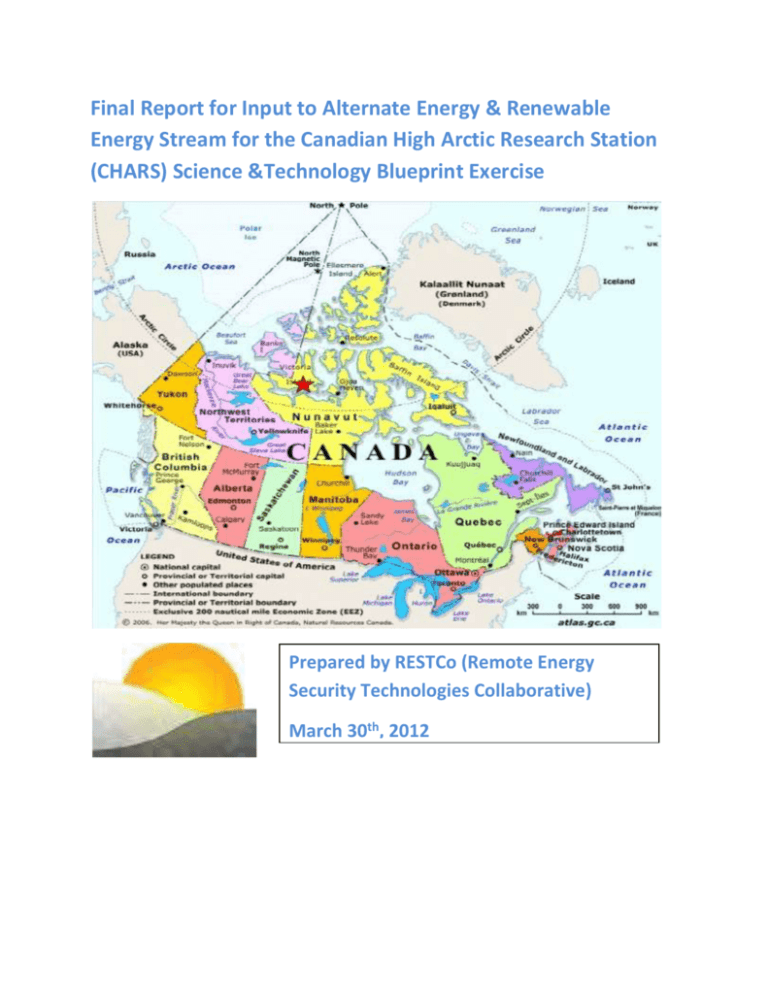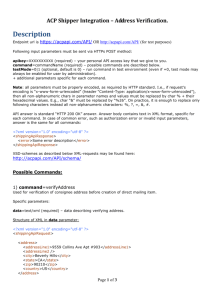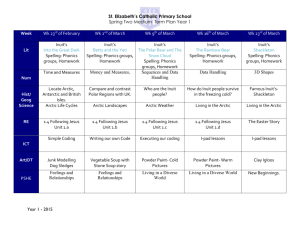Science and Technology Blueprint for the Canadian High
advertisement

Final Report for Input to Alternate Energy & Renewable Energy Stream for the Canadian High Arctic Research Station (CHARS) Science &Technology Blueprint Exercise Prepared by RESTCo (Remote Energy Security Technologies Collaborative) March 30th, 2012 Alternate Energy and Renewable Energy Stream for CHARS Science and Technology Blueprint Executive Summary We identified a serious need for an energy research station in the Canadian High Arctic. The High Arctic is unique in that there is significant uncertainty, in economic development, climate change impacts, and population growth. Locating in the North will give CHARS the needed flexibility to respond to quickly-changing circumstances. Successful energy system implementation demands specific field research and testing in close collaboration with Northerners. The science, engineering, development and evaluation of AE & RE technologies done at CHARS need to serve the needs of the north. The success of the Alternate Energy (AE) and Renewable Energy (RE) program within the Canadian High Arctic Research Station (CHARS) will be a function of how well it aligns with the unique properties of its location and the demands of Arctic communities, including: Geography Climate Access to a population that lives in the north on an extended basis Integration of indigenous traditional knowledge and cultural customs with state of the art energy technology and systems Access to, and possibly reliance upon, an isolated community micro-grid CHARS needs to be much more than a single, stand-alone facility. It should be the hub of a virtual network of northern institutions, researchers, scientists, engineers, teachers, students and other knowledgeable practitioners, with connections to the south as well to maximize the reach and capabilities of the facility. It also needs to be intimately connected with its physical community of Iqaluktuutiaq or Cambridge Bay. While we expect that the CHARS facility will incorporate AE and RE technologies and techniques to reduce its own operational energy needs and costs, and serve as a showcase for the viability of those technologies in the Arctic, this is not the key role for the facility regarding AE & RE. Instead, as a research station, CHARS should provide an instrumented and monitored test-bed environment for the evaluation and refinement of future sustainable technologies in harsh operating conditions – technologies we don’t even know of today. CHARS should also be designed with sufficient flexibility to be able to adopt such technologies for its own internal use when they have been proven to be of value. Life in the Arctic is changing at an accelerating pace. To be truly effective as soon as possible, CHARS cannot wait until 2017 to start its ‘operational’ life. Instead, CHARS needs to start establishing its role and functions before the physical facility opens. Some of this will be the necessary preparations for opening and operating the facility, but some of it is work that can be RESTCo – Remote Energy Security Technologies Collaborative (RESTCo.ca) 2 Alternate Energy and Renewable Energy Stream for CHARS Science and Technology Blueprint done and provide value before the facility opens. For example, CHARS should not wait until 2017 to establish benchmark and trend information on energy use by community and sector in Nunavut; it should have that information in hand when CHARS becomes operational (more examples are provided in the body of this document). CHARS should develop a knowledgeable population of potential staff during the pre-operational period to provide some of the staffing for the facility amongst the pool of northerners via training and knowledge transfer. CHARS represents an exciting opportunity and plays a crucial role for fostering and supporting the practical implementation of alternate and renewable energy approaches, including efficiency, adoption of new technology and energy consumption practices and conservation, for northern communities so as to reduce their dependence on imported fossil fuels and to support future development while reducing the environmental impact associated with energy use. RESTCo – Remote Energy Security Technologies Collaborative (RESTCo.ca) 3 Alternate Energy and Renewable Energy Stream for CHARS Science and Technology Blueprint Contents Executive Summary ................................................................ 2 Contents ................................................................................ 4 Work Done ............................................................................. 5 Conclusions ............................................................................ 6 Appendices .......................................................................... 12 Session Notes ........................................................................................................................................ 12 March 8th, 2012 Presentation Deck ..................................................................................................... 20 Indigenous Collaboration in CHARS Energy Program .................................................................. 21 RESTCo – Remote Energy Security Technologies Collaborative (RESTCo.ca) 4 Alternate Energy and Renewable Energy Stream for CHARS Science and Technology Blueprint Work Done RESTCo drew upon its network of associates to examine the issues around the AE & RE subject area, from policy to indigenous collaboration to northern needs and desires. After a review of previously produced material related to CHARS and the energy stream for the science and technology blueprint, we developed some areas to guide a conversation with experts. A preliminary paper that identified the approach was developed and submitted to AANDC. RESTCo conducted a canvass of roughly 30 individuals with relevant experience and expertise to obtain input at a high level to help guide the exercise. A full day session was held with experts from the Arctic and the northern boreal region, bringing expertise related to northern communities and energy implementations. Based on the information developed from that work, a presentation document set was developed and distributed to the Alternate Energy Technical Committee for comment. A conference call was held to collect feedback from the committee members, and additional feedback was received via e-mail from some committee members. The information developed from this process has been analyzed and synthesized into this document. RESTCo – Remote Energy Security Technologies Collaborative (RESTCo.ca) 5 Alternate Energy and Renewable Energy Stream for CHARS Science and Technology Blueprint Conclusions It is tempting to simply look at a list of current promising technologies and simply try to patch them onto the CHARS facility, in part because RESTCo maintains such a list in our solutions portfolio. However, CHARS will not be operational for at least 5 years, so a promising technology today (e.g., LED lighting) may well be mainstream building technology by the time the CHARS physical facility is operational. Furthermore, the CHARS facility is expected to have an operational life of 40 years or more. In 1970, the microprocessor, pocket calculator and cellular telephony did not exist. Today, we can’t imagine daily life in the industrialized world without them. We should expect and plan for many such innovations with quantum scale effects to occur before the CHARS mission is complete. All participants want to see resources used wisely, efficiently and effectively. Research that can be done as well, but at lower cost, in the south should be done in the south. The work done at CHARS needs to serve northerners, while taking advantage of the unique attributes of the CHARS facility and location. While renewable energy and alternate fuels are expected to be implemented in the facility as part of its operations and to showcase the capabilities, the greater value in CHARS is to help develop, evaluate and refine energy technologies for use in the north in the future over the lifetime of the facility. One vision of this ability is to have CHARS facilitate the shift away from imported fossil fuels (notably diesel / heating fuel and gasoline) to sustainable local energy sources for northern communities. The primary forms of energy used in the north today are for heat and electricity, and these should be the focus of northern energy research, including connectivity (‘plug & play’), monitoring and storage of relevant energy forms. Work should be done prior to the opening of the CHARS facility in a pre-operational phase to maximize the benefits to be derived from the investment in the shortest reasonable timeframe. This ‘pre-operational phase’ work could include (but is certainly not limited to): I. Pre-operational Phase: A comprehensive needs assessment should be conducted. This assessment would include local demand and resources in Arctic communities, including the main uses of energy, behavioural aspects, and inputs and wastes from the community. This could be modeled on the carbon footprint analysis currently being conducted by Yukon College in Burwash Landing and Destruction Bay. RESTCo – Remote Energy Security Technologies Collaborative (RESTCo.ca) 6 Alternate Energy and Renewable Energy Stream for CHARS Science and Technology Blueprint Quantitative monitoring should also be a component of the needs assessment. Current examples from Qulliq Energy Corporation (QEC) include a project to install wind monitoring towers in Arviat and Cape Dorset, and monitoring of the electrical consumption in Cambridge Bay at 1-minute timesteps. These kinds of monitoring projects, conducted in a comprehensive manner across the Arctic, could be a core function of the energy program at CHARS. Another example of resource assessments is a recently-released consultant report from the Energy Secretariat of the Government of Nunavut. The Nunavut Renewable and Alternative Resources Inventory studied the feasibility of various renewable and alternative energy resources for Nunavut, including biofuels, solar, hydro, wind, nuclear, and others. The scope of the report included a gap analysis, interviews, analysis of resource availability, and desktop pre-feasibility analyses of three communities using the RETScreen scenario modelling software. The development of consumption profiles, based on population, climate, and level and type of economic activity. It was noted that per-capita electricity use varies greatly across communities. By closely monitoring ‘archetypical’ communities, it may enable the creation of indicative community load profiles. A similar project was conducted in Alaska, titled the ‘Alaska Village Electric Load Calculator’ (http://www.nrel.gov/docs/fy05osti/36824.pdf). However, directly monitored load data is better than a modeled load profile. The needs assessment can also evaluate the existing building stock. This evaluation would identify options for energy efficiency retrofits and provide information for both future building design and science programming decisions. As an example, as walls and windows become tighter and provide better thermal insulation, heat and air loss through the building envelope is reduced. Other building elements, such as ventilation, become the dominant source of energy consumption. By understanding the current building stock, technologies and approaches having the greatest potential impact can be identified and allocated funding. Support for a communication plan to establish 2-way communication pathways in the near term with the stakeholder communities for CHARS (immediate physical community, northern educational and research institutions, networks and individuals, Inuit community beyond Iqaluktuutiaq, southern research community, territorial governments, federal government departments and agencies, relevant industrial groups with energy technologies.) RESTCo – Remote Energy Security Technologies Collaborative (RESTCo.ca) 7 Alternate Energy and Renewable Energy Stream for CHARS Science and Technology Blueprint Energy analysis and trend reporting for Iqaluktuutiaq (Cambridge Bay), based on currently available data and implementing future monitoring and data acquisition tools. This would start with a baseline energy consumption profile and community energy plan. Watching brief on appropriate AE & RE technologies. Input into the food security stream design. 'Country food' is at severe risk as a result of climate change, so alternatives will be critical, and the energy equations point to continuous imports as being a non-solution. Local production will be key, which requires careful thoughts about local energy and transportation system requirements. Input into the housing stream design - housing and buildings are major users of energy, and therefore of key interest to the AE & RE work. The design has to accommodate monitoring and data acquisition at all available connection points, and allow for twoway flows of energy - heat and electricity. Development of a low/zero fossil fuel transportation energy stream, and design for it. Infrastructure design that will permit both interconnection with the existing community energy grids (electricity and heat), monitoring of energy flows at connection points, and islanding of the CHARS facilities if necessary. Work with the facility designers regarding implementation of AE & RE technologies in the initial build. Work with the facility designers regarding the upgrade to future technologies within the structure, and accommodating the accommodation of test beds for evaluation of technologies under Arctic conditions. Input into a training and knowledge transfer plan to build up an inventory of potential staff for CHARS when it commences operation. II. Role of CHARS once it is in operation Given the problems associated with transportation of fuels, a key issue will be securing local energy resources. The scope of this S&T outcome should not be constrained to the CHARS facility or Cambridge Bay, but rather should develop pan-Arctic solutions. Thus, identification of local energy resources, along with climatic constraints and opportunities, should be an integral component of the program. RESTCo – Remote Energy Security Technologies Collaborative (RESTCo.ca) 8 Alternate Energy and Renewable Energy Stream for CHARS Science and Technology Blueprint In any isolated community off the main grid, the ability of the local grid to absorb nondispatchable power is far more constrained. Therefore, matching resource to load and having at least some short-term storage is essential to the success of a variable renewable energy project of any significant penetration level. Storage research should include both electric and thermal storage. Long-term research could include diurnal or seasonal storage. A holistic, integrated approach should be taken to energy systems. This approach should explore a number of different options, including combined heat and power (CHP), capture of waste energy and energy from waste, smart mini grids, demand side management, building science, and wind, solar, and hydro renewable resources. In Nunavut, a policy is being developed for grid feed-in for independent power producers. These types of policies have an obvious technical component, as unrestrained feed-in could cause issues with safety and reliability of the diesel grid. Thus the CHARS S&T program could provide technical input to the policy process. One example is developing technology that is extremely reliable and easily maintained (e.g. the ‘Stephen Mooney Fix-With-A-Rock Approach’). There is a clear need to ensure energy technology is reliable – see for example the history of failed wind experiments in the Arctic. Another example is the use of simulation models. Although energy simulation per se does not imply a unique role for CHARS, the ability to compare simulated results to measured results is extremely valuable. By validating simulation models using on-theground performance testing and monitoring, CHARS can promote the use of simulation as a tool in energy projects, including building design. This can reduce uncertainty, risk, and cost in energy projects. Simulation tools can also provide quantitative input to cost/benefit analyses and research program decisions. In addition to technology development, technology deployment could be a key role for CHARS. CHARS could assist the power corporations, government departments, and communities in the Arctic to evaluate energy use and supply options, and provide expertise in energy projects. This could include partnering with existing institutions such as QEC and Yukon College, and additionally working with private industry to bring technologies to the market. These could be novel technologies or mature ‘Southern’ technologies that need to be adapted for use in the North. A ‘phasing’ or RESTCo – Remote Energy Security Technologies Collaborative (RESTCo.ca) 9 Alternate Energy and Renewable Energy Stream for CHARS Science and Technology Blueprint ‘incremental’ approach may be necessary to gain local acceptance of unfamiliar technologies, again suggesting a role better suited for a Northern institution. CHARS can also play a key role in investigating social integration of new technologies. Without buy-in from business, government, and consumers, new or adapted technologies could be seen as too risky and the status quo will remain. In addition, the wide cultural differences seen across the North mean that a one-size-fits-all approach to energy will not work. Transportation technologies should also be investigated. Range limitations of electric vehicles may be less of a constraint in small northern communities. The implication of electric motive power on community energy grids needs to be investigated. CHARS should also provide a role in training / employment / apprenticeship. A common refrain in the North is lack of capacity. Energy projects and technologies require specialized skills which may be lacking in many communities. In particular, moving away from the status quo of diesel fuel will require new skills and training. CHARS could anchor a pan-Arctic ‘Energy Centre of Expertise’. It was also noted that CHARS should not be in the program implementation business, but rather work with program implementers such as QEC. III. Next steps 1. Expand upon CHARS’ unique role in greater detail including: Developing technology that works in the North, including energy storage, demand-side management techniques, transportation, and energy supply. An emphasis should be placed on cost, reliability, and recognition of unique cultural, social, and economic conditions in the North. Provide expertise and assistance integrating renewable energy solutions into isolated diesel grids. This includes a detailed needs assessment of Northern communities. Identification of local/regional renewable and unconventional fossil fuel resources across the North. Validate simulation models through monitored energy projects. Assist with energy policy development. Work with communities to build capacity through training and workshops, and phasing-in of unfamiliar technology. Empower northern communities to take energy needs into their own hands. RESTCo – Remote Energy Security Technologies Collaborative (RESTCo.ca) 10 Alternate Energy and Renewable Energy Stream for CHARS Science and Technology Blueprint Provide a ‘Centre of Expertise’ for program implementers such as the power corporations. Involve industry representatives in the technical committee. Develop comprehensive list of current project and programs, and other institutions working on Arctic energy issues. Examine other projects in Arctic and Antarctic regions to establish the ‘current state of knowledge’ with regards to cold climate energy. Use past and current projects to identify and define a ‘whole of government’ approach, to optimize dedication of resources and prevent duplication of effort. 2. Define the Pre-operational phase 3. Clearly define the first 5 years of the S&T Program 4. Define a vision for CHARS for 5-15 years after its launch RESTCo – Remote Energy Security Technologies Collaborative (RESTCo.ca) 11 Alternate Energy and Renewable Energy Stream for CHARS Science and Technology Blueprint Appendices Session Notes CHARS meeting Feb. 13, 2012 Factors affecting Energy supply in the North / CHARS Climate change Understanding balance between saving energy and creating energy Poor construction technique Little capture from waste heat Dynamic wall Skewed demand incentives How is energy perceived in the community Socio economic factors Disconnect between energy supply and use Incentive to change energy use behaviour Energy from the sea (tidal) more reliable than sun or wind (Swedish, peter) How do we build houses in the Arctic Manuf houses in the Arctic Dirigibles to improve transport “poop” power + green waste to methane Energy storage through compressed air (bladder) shoreline could offer advantages Reliability Human capacity Mode to safe fail RESTCo – Remote Energy Security Technologies Collaborative (RESTCo.ca) 12 Alternate Energy and Renewable Energy Stream for CHARS Science and Technology Blueprint Small scale wind generator Appropriate scale Monitoring performance (house, fuel consumption, water) – strain gauges in houses Preventive and predictive maintenance Standardization Energy source – security Economic development vision CAPITAL Disconnect between government players & land claim institutions Failure in communication between stakeholders Facilitation of communication & joint economic planning Community as a unit of Interest Capacity available to respond to community needs Working in the North Location in permafrost/rock (environment/climate change) Adaptability of design Anticipated knowledge of technological trends Compatibility with current infrastructure Transition to new sources of energy Long term planning (stakeholders involvement) Community involvement High economic pressure NEEDS assessment on the long term RESTCo – Remote Energy Security Technologies Collaborative (RESTCo.ca) 13 Alternate Energy and Renewable Energy Stream for CHARS Science and Technology Blueprint 6 Conservation & construction innovations not incorporated e.g., SIPs Decision-makers change resistant Jobs in the north vs. lower cost (south built modular, etc.) e.g., Efficient washing machines, low flow toilets, showers, efficient lights Political will CHARS leadership role in showing the way NAM lacks clout 7 Desire for collaborative process (NAM, CHARS, GN) work with NRI, Aurora, Yukon College … Pang Project – single simplified funding channel Pang Youth Council Want to send Pang youth to CHARS for work Municipal Training organization (MTO) Apprenticeship program barrier Contractors organizations as opportunity channels Youth opportunity Need advice, training incentives CHARS as teaching tool 8 NWT has AEA – GN needs equivalent (used to have something at QEC) CHARS as this for GN ? RESTCo – Remote Energy Security Technologies Collaborative (RESTCo.ca) 14 Alternate Energy and Renewable Energy Stream for CHARS Science and Technology Blueprint CHARS strategic AEA on the ground Broadband as substitute for people in place (plus other valuable contributions) Technology / knowledge/ communications Implementation channels Permafrost as area of study & actions Traditional knowledge capture & use (vs. DFO experience) Igloos work Dogrib log housing 9 Players CMHC DND (DRDC) Arctic Council AEA CANNOR NAM NWT Yukon Nunavik GN Fairbanks Cold Climate HRSDC Makivic QEC HQ ITK ICCC NTI x 3 regional bodies Arctic College Yukon College Aurora College F F I housing Research Resilience assessment N F M T T Implementation EcDev T I F Training EcDEv Reg Gvmt Utility Electricity Health research RESTCo – Remote Energy Security Technologies Collaborative (RESTCo.ca) 15 Alternate Energy and Renewable Energy Stream for CHARS Science and Technology Blueprint Nunavut East Arctic Shipping Company & competitors Green NGOS check with EcoJustice Commercial energy retrofit companies eg. GE Northern Industrial entities Other clients IEEE Canwea Cansia NRCan Renewable Energy Retscreen group Airlines NRC Cambridge Bay Home builders & construction Co Nunavut Housing Sectors / Disciplines to be harnessed Teaching / training / education Building knowledge & capacity CHARS – Nunavut annual science projects – schools CHARS roadshow into communities No scheduled boat service between communities Marry scientific monitoring with TK – integrate into curriculum RESTCo – Remote Energy Security Technologies Collaborative (RESTCo.ca) 16 Alternate Energy and Renewable Energy Stream for CHARS Science and Technology Blueprint Build on IPY northern contaminant program Develop networks Market development (out of the lab) NRC, STDC, CANNOR, FCM Business incubators (NRC, IRAP, CANNOR, Industry Canada) Policy (e.g., Independent power producers) Ecology & Anthropology+ economics as part of CBA Circumpolar information exchange Nutrition / wellness (housing wellness) Food production (water and food security) Sectors Industries Infrastructure Transportation Fishing Oil & gas Mining Housing / construction Industry driven research Industry enabled research What is success / barriers ? RESTCo – Remote Energy Security Technologies Collaborative (RESTCo.ca) 17 Alternate Energy and Renewable Energy Stream for CHARS Science and Technology Blueprint AE & RE implemented on a large scale Changed the face of the north Will have to push for deployment (political will) Provide solutions for indentified community needs (Canadian Arctic) - manage process for implementation - incorporate TK Customer defined / market pull Needs assessment (even before construction) What are the issues ? (eg. Dry wall, paving, dust suppression) Catalyst Uniqueness No Energy secretariat in Nunavut Long natural cold period Arctic location Scientific research for Northerners Sole real world Arctic issues CHARS as “natural home” for Arctic origin researchers Spin off benefits to local community and beyond RESTCo – Remote Energy Security Technologies Collaborative (RESTCo.ca) 18 Alternate Energy and Renewable Energy Stream for CHARS Science and Technology Blueprint Transportation Cost Frequency Ice breaker service Resource development as driver Weather / climate changes Fuel delivery risks (hoses, pumps, grounding) Resolute spill recent RESTCo – Remote Energy Security Technologies Collaborative (RESTCo.ca) 19 Alternate Energy and Renewable Energy Stream for CHARS Science and Technology Blueprint March 8th, 2012 Presentation Deck RESTCo – Remote Energy Security Technologies Collaborative (RESTCo.ca) 20 Alternate Energy and Renewable Energy Stream for CHARS Science and Technology Blueprint Indigenous Collaboration in CHARS Energy Program The energy research program at CHARS offers an excellent opportunity for researchers to establish a positive and mutually beneficial working relationship with the people and communities of the far North. The inherent ambition of Inuit people to return to the level of energy self-sufficiency experienced by their ancestors, as well as to acquire the degree of energy security necessary to support a modern lifestyle and economy, suggests this program as an immediate and obvious vehicle for collaboration and an ideal occasion to engage Northern people in the work of developing and piloting new and emerging CHARS technologies. The development of a positive working relationship with local communities is, however, not likely to be spontaneous. As a southern-driven, southern-financed, largely academic institution, CHARS will inherit a legacy of distrust and cynicism born of many decades of less-thanrespectful practices by southern scientists undertaking academic research in Inuit territory. It was only in the early 1990’s that any real effort was made at the institutional level by southern governments and academics to inform, consult with or report to Inuit peoples on the nature and outcomes of scientific studies undertaken on their lands. The Northern Contaminants Program (1991), the international Arctic Monitoring and Assessment Program (AMAP, 1991) and later the Arctic Council (AC, 1996) represent watershed moments with respect to the engagement and inclusion of the indigenous voice in Arctic research. Later, the settlement of land claims and the institution of independent or co-management governance regimes, including the creation of the territory of Nunavut, served to sensitize southern researchers to the need to respect the aboriginal residents living in the regions beneath their microscopes. Yet despite significant progress, tokenism, academic arrogance and paternalism remain evident to this day. Against this backdrop, CHARS will have to make significant efforts to involve and engage the Inuit community from the outset of its mandate if there is to be any hope of their programs being truly welcomed by Northern communities. Most importantly, CHARS must ensure that its work is relevant to and reflective of the needs and priorities of Arctic stakeholders. How can this be most effectively done? The first key to success will be the establishment of respect for Inuit culture, knowledge and land as a guiding principle in all relationships and programs undertaken at CHARS. Recognition must be given to the fact that the station is to be located on the ancestral territory of the Inuit and southern personnel, as guests to this region, must conduct themselves accordingly. Measures as simple as referring to the community by its Inuit name of “Iqaluktuutiaq” rather than “Cambridge Bay” can go a long way in demonstrating respect. Secondly, it is imperative that CHARS invite Inuit representation on all of its steering committees right from the start and that the communities and leadership be directly involved in RESTCo – Remote Energy Security Technologies Collaborative (RESTCo.ca) 21 Alternate Energy and Renewable Energy Stream for CHARS Science and Technology Blueprint determining research priorities and agendas. To be consulted after the station is established and/or the main projects have been determined smacks of tokenism but has all too often been the pattern with past scientific initiatives. Thirdly, positive working relationships must be established from the start with the territories’ existing research institutes (e.g., Nunavut Research Institute [NRI], Aurora Institute, etc.), the major indigenous organizations (Inuit Circumpolar Council Canada [ICCC] , Inuit Tapiriit Kanatami [ITK], Arctic Athabascan Council [AAC], etc.), and the academic institutions of the Arctic. As the “new kid on the block”, CHARS must ensure that the energy research priorities of these stakeholders are recognized and incorporated into the CHARS agenda; likewise the knowledge base, connections and experience of these longstanding institutions are invaluable. CHARS would be well-advised to take advantage of their respective capabilities and incorporate their knowledge, resources and personnel to the greatest extent possible in any proposed energy project. The traditional knowledge (TK) of indigenous peoples has been an asset long overlooked and marginalized by academic and southern research institutions. Awareness that there are indeed “two ways of knowing” has been slow to permeate academic culture and gain legitimacy in Arctic research but recent initiatives, such as the multi-million dollar “Voices from the Bay” project, have done much to help TK achieve the respect it merits. CHARS has the opportunity to further this agenda by establishing respect for indigenous knowledge as a working principle of the station and mandating the inclusion of indigenous knowledge in all of its work. Direct collaboration with agencies such as ITK’s new Inuit Knowledge Centre and a commitment to meaningful consultation and dialogue with Inuit experts should be priorities in the methodology of any research project, making the question “what do the elders say?” one of the first to be asked when contemplating any new project or initiative. The existence of “two ways of knowing” also introduces the potential for capacity building in two directions: among southern researchers who may not be familiar with the culture, climate and idiosyncrasies of the Arctic and among northerners who do not have access to the same educational opportunities, resources and expertise found in southern academic institutions. “Science bush camps” provide an excellent opportunity for southern researchers to experience a total immersion in Inuit culture and develop a true appreciation and respect for indigenous knowledge and peoples. Likewise Arctic communities will look to CHARS to create opportunities and programs for Northerners, and particularly northern youth, to gain greater scientific proficiency, skills and literacy. To this end, the energy program should actively collaborate with colleges to develop workshops, curricula, internship and apprenticeship programs that will allow students to engage in meaningful research and develop the technical skills and expertise necessary to participate in the development and maintenance of any new RESTCo – Remote Energy Security Technologies Collaborative (RESTCo.ca) 22 Alternate Energy and Renewable Energy Stream for CHARS Science and Technology Blueprint energy systems established in the Arctic. The establishment of a CHARS student association, possibly in affiliation with the ArcticNet Students Association (ASA), should be encouraged and actively supported and could become highly instrumental in establishing a new generation of scientifically-literate, skilled and competent Inuit researchers and leaders. The issue of funding has long been a source of tension between many scientific programs and Inuit organizations and communities. These tensions are often related to differing cultural perceptions around the value of indigenous knowledge and un-credentialed expertise as well as issues of reporting, accounting and accountability. Many paternalistic attitudes still exist among southern governments and researchers toward Inuit and money in general while Inuit for their part often resent the endless red tape involved with accessing southern funding. While these attitudes and cultural differences will take time to overcome, CHARS energy projects would do well to ensure that funding is fairly distributed among its Northern collaborators and that individuals are compensated adequately for their time and expertise, including compensation for time dedicated to consultations. Efforts should be made to source supplies and services through local businesses and to ensure that the CHARS energy program brings significant economic stimulus and benefit to the community beyond that of its research outcomes. Communications has also long been the Achilles heel of north-south working relationships and is consistently cited by Inuit as one of the shortcomings of most southern-based research projects. A strong outreach program – one that includes town hall meetings, formal and informal consultations, participation in community events, social media and regular visits to elementary and high schools - is essential to ensure that the community is informed about the projects being undertaken. Equally important is the assurance that all scientific communications and reporting is transparent, written in plain language and translated into appropriate aboriginal languages. Press releases should consistently include a “northern voice” (quote or content by an indigenous researcher, political leader, elder, etc.) and every effort should be made to utilize local radio, television and social media to ensure that residents are aware of new energy projects and invested in their success. Finally, it is crucially important that CHARS not become a burden on the community. It must have at its disposal sufficient assets and resources to deal with any and all emergencies that might arise as a result of the station’s research work (search & rescue, fires, accidents, etc.) and ensure that no additional pressure is placed on local residents and resources (e.g., the health centre) in the case of an incident. Likewise, the assets of the station (ATVs, boats, medical supplies, staff, etc.) should be made available to the community to assist in any community search and rescue efforts, fire or emergency situations. Not only would this reflect CHARS responsibility as a good corporate citizen, it would demonstrate how the research station can bring “value added” to the community and contribute to its security and well-being. RESTCo – Remote Energy Security Technologies Collaborative (RESTCo.ca) 23 Alternate Energy and Renewable Energy Stream for CHARS Science and Technology Blueprint The Inuit are traditionally a warm and welcoming people but recent history has not been entirely kind. The rapid social transition from nomadic self-sufficiency to a community-based western lifestyle, the legacy of residential schools, misguided government policies and poverty have led to a high degree of social and cultural dysfunction in many communities. That being said, there remains a tremendous resilience and resourcefulness in this population as well as a vast wealth of traditional knowledge that when blended with new innovations and technologies, has huge potential to contribute to the development of some of the most exciting and progressive energy systems in the world. Young people are hungry for opportunity and experience and are looking to institutions like CHARS to provide an outlet for their energy and creativity. The steps needed to secure a positive working relationship with Northern communities are not difficult, but so often fail because the principles and high ideals that appear on paper are not translated into practice. The energy program at CHARS has the potential to profit greatly from a close collaboration with Arctic communities, institutions and stakeholders and to move forward the agenda of north-south cooperation and collaboration in Canada to the benefit of all. (This section of the document was prepared by RESTCo associate Liane Benoit, and has been previously distributed at the request of the AANDC project authority.) RESTCo – Remote Energy Security Technologies Collaborative (RESTCo.ca) 24







